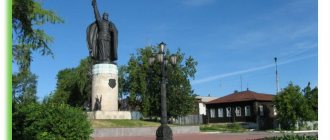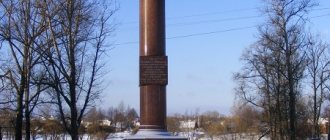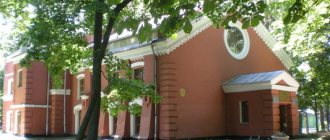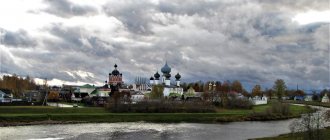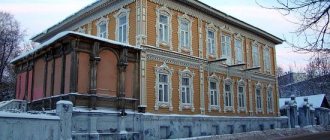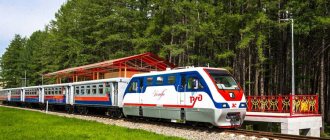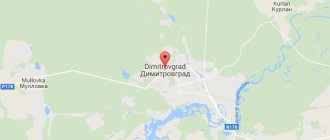Church of the Smolensk Icon of the Mother of God, called “Hodegetria”
The church in these places appeared in the 17th century and is popular among believers throughout the region. The attraction is included in the UNESCO World Heritage List.
This is a unique example of Russian architecture, a creation created at the turn of change, when the tent style was becoming a thing of the past. Only three such churches have survived in the country: in Vyazma, Putinki and Uglich.
The temple is located on Dokuchaev Street, 48A.
Church where two saints were baptized
What to visit : Church in honor of the Transfiguration of the Lord with the chapels of the Intercession of the Blessed Virgin Mary and the icon of the Mother of God “Burning Bush”.
Where: Strakhovoy Lane, 4.
What's interesting : The small Transfiguration Church, in which two saints of the Russian Orthodox Church were baptized: St. Macarius (Glukharev; 1792-1847) and Martyr John (Popov; 1867-1938), stands on a hill, east of the historical center of Vyazma. The church was erected in 1736 at the expense of the merchant Ivan Grigorievich Vyaznev.
On the western wall of the Transfiguration Church, fragments of paintings from the mid-19th century have been preserved, depicting Saints Equal-to-the-Apostles Constantine and Helen, and the Slavic enlighteners Cyril and Methodius. Like them, Saints Macarius (Glukharev) and John (Popov) devoted their entire lives to missionary activity.
Church of the Nativity of the Virgin Mary
This is a brick structure erected from 1782 to 1785. The bell tower of the church is free-standing, and the temple itself was built in the Baroque style. The church is also known for the fact that in 1812 liberation battles from Napoleonic troops were fought near its walls.
The church is located at Sovetskaya Square, 3 and since 1970, after restoration work, it has housed a local history museum.
Excursion routes
The most popular excursion route is a visit to the Khmelita Museum-Reserve and a sightseeing tour of the city of Vyazma. The sights that can be seen by choosing this route are, first of all, the Griboyedov estate, located 37 kilometers from the city, as well as the most beautiful churches of Vyazma - the Trinity Cathedral and the Cathedral of the Mother of God Hodegetria.
In addition, guests visit the local history museum, get acquainted with the history of the city, and can see the city’s most beautiful churches and monuments related to the events of the Great Patriotic War.
Holy Trinity Cathedral
This is the main cathedral of the city, built in 1676. Located on the left bank of the river, on the territory of the fortress. The first mention of the St. Nicholas Church (old name) is in the chronicles of 1015. In 1635 it was renamed Holy Trinity Cathedral. In 1812, the building was completely burned. Later, the temple was restored with funds allocated by the merchant Sabelnikov in 1847.
Today it is a two-altar cathedral, made in the classical style typical of Moscow churches at the turn of the 16th century. The decorative elements of the building are made in pseudo-Russian style.
The temple is located on Nagornaya street, 1.
History of Vyazma
The small but rich city of Vyazma is located in the Smolensk region and is a regional center with a population of 52 thousand people.
The date of origin of Vyazma is considered to be 1239, when it was first mentioned in historical sources. In fact, a settlement in this place arose at the end of the 11th century, and in 1239 it grew into an urban settlement. Vyazma is named after the river on which it stands. This river connected or “linked” three large water arteries: the Dnieper, the Volga and the Western Dvina. There are other versions of the origin of the city's name. For example, because it was built on clayey, “sticky” soil.
Vyazma was part of the Smolensk Principality until 1403, then it became part of the Principality of Lithuania. At the end of the 15th century it returned to the Russian lands. In the 17th century, Vyazma was engulfed in the events of the Time of Troubles; government troops and rebel detachments operated on its territory. Numerous battles with the French army took place here in 1812.
In Soviet times, the city was heavily destroyed during the Patriotic War and was under German occupation for a long time.
The historical and cultural significance of the city today lies in the fact that here you can get acquainted with the church architecture of the 12th-18th centuries. In the vicinity of the city there are museums - estates of the 18th century. The attractions of Vyazma also include numerous places where the events of the Patriotic Wars of 1812 and 1941-1945 took place.
Svetlana Savitskaya's plane
Between Repin Street and 25th October Street, on the territory of a small city square, a monument to Svetlana Savitskaya was erected. This is a real MiG-17 model aircraft. It was on this aircraft that Svetlana began her training.
The design of the monument is presented in such a way that it seems that an airplane is taking off. Savitskaya is an honorary citizen of the city and twice a hero of the Soviet Union.
Epiphany Church
This is a functioning temple in Vyazma, with a rich iconostasis. The building is snow-white, with blue domes, and is open to visitors by believers. It was built in the 18th century entirely with donations from local residents. The architecture of the building is elegant, it is made in the Baroque style.
A local history museum has been opened in one of the cathedral's premises. The church still operates a library, a Sunday school, and an Orthodox camp for children.
Thematic exhibitions and fairs with the participation of folk craftsmen are often held on the territory of the temple.
The temple is located on Paris Commune Street, 18.
Architectural objects and monuments of Vyazma
In the city center, not far from Soviet Square, on the streets of Kronstadt, Hegel, Paris Commune, Karl Liebknecht, Herzen, you can see monuments of urban architecture of the 18th-19th centuries. In the suburbs of Vyazma, namely 37 kilometers from the city, there is a museum-reserve, the former estate of the Griboedov family and now the Khmelit Museum. The poet Alexander Griboedov also visited here.
The estate was built and flourished in the 18th century. In the second half of the 19th century it was in a deplorable state. The new owner, Count Pyotr Alexandrovich Heyden, restored it. During Soviet times, the house suffered greatly from destruction, looting, and fire. Restoration began in the 60s. The museum opened in 1988.
The main exhibition includes objects of art and everyday life from the late 18th – first third of the 19th centuries. Temporary thematic exhibitions are also held. In 2002, a museum of Admiral Pavel Stepanovich Nakhimov, a native of the Smolensk region, appeared on the territory of the estate. It is located in the building of the former Griboedov greenhouse.
The admiral's workplace has been recreated here, photographs and archival documents have been collected. On the second floor of the museum there is an exhibition of paintings depicting battles in which Pavel Stepanovich participated, as well as models of warships. In the immediate vicinity of the Khmelita estate there are several more historical architectural monuments.
These are the Transfiguration Church of the late 18th century in the village of Grigorievskoye, the Church of the Ascension of 1793 in the village of Torbeevo, the garden and park complex of the 17th-19th centuries in the village of Lipitsy, the Akhtyrskaya Church of 1819 with preserved paintings in the dome and the chapel in the village of Pigulino, the Trinity Church of 1820 in the village of Fedyaevo, the Sheremetev estate of the mid-19th century in the village of Shirokoe.
Within a radius of 20 km from Khmelita, you can visit the Baryshnikov estate of the 18th - 19th centuries with preserved religious, residential, utility buildings, and partly a park.
It is located in the villages of Nikolo-Pogoreloe and Aleksino. The estate of Count Panin in the village of Dugino is a well-preserved park, cascading ponds, as well as partially extant outbuildings and two wings of the palace.
Monument to General Efremov
A monument to the general was erected on Efremov Square. He was the commander-in-chief of the 33rd Army. The general himself died in 1942 in battles in Vyazma. There is a tragic story associated with his death. When the regiment was surrounded and Efremov was wounded, in order not to be captured, he committed suicide. Efremov received the title of Hero of Russia posthumously in the 90s.
The monument was erected in 1946. This is a pedestal with 5 figures, one of which is a general, he gives commands to his soldiers to go into battle. The monument is made of gray granite.
Historical monuments of Vyazma
Vyazma, whose sights preserve the memory of the events of the Great Patriotic War, remembers and honors its heroes. In the center of the city there is an Eternal Flame on Efremov Square and a monument to General Efremov. Also in 1989, a Stele in memory of those killed in the Great Patriotic War was installed on Yamskaya Street.
Another war, the Patriotic War of 1812, is dedicated to the Monument to the Valiant Ancestors. It is located near the Pobeda cinema, which is located at Lenin Street, 13. This is a figure of a double-headed eagle tearing the French flag.
It was first erected in 1813, then suffered greatly during Soviet times. Restored and reopened in 1962 in honor of the 150th anniversary of the Battle of Borodino. More recent attractions include the monument to the scientist Konstantin Eduardovich Tsiolkovsky. Located in a park on Sverdlova Street, built in the 60s of the 20th century.
Stele "Vyazma - the city of military glory"
The stele is located on Soviet Square. Nearby there is a monument perpetuating the glory of the Pernovsky Regiment and the “Mother’s Heart” monument.
In 2009, the city received the title “City of Military Glory” and already in 2011 the grand opening of the stele took place.
This is a high column (6 meters), topped with the coat of arms with the heraldic shield of the Russian Federation. The coat of arms depicts a double-headed eagle with several small gold-colored crowns and one large one, connected by a ribbon. The eagle holds a scepter with its right paw, and an orb with its left.
On both sides of the stele there are cubic granite pedestals, on which the main events that took place in Vyazma are depicted: graphic scenes of the Patriotic War and the Second World War.
The Griboedov Estate is the best park attraction in Vyazma and its environs
Griboyedov's estate in Khmelita
Connoisseurs of Alexander Griboyedov's work and lovers of quiet walks through beautiful parks should definitely visit Khmelita
. This is a picturesque park-museum located 37 km from Vyazma, where the estate of the Griboyedov family is located. The building itself, where the museum is located, was built in the Elizabethan Baroque architectural style. The structure of the estate was seriously damaged after the revolution, and the interior items and family heirlooms of the playwright were taken to the capital. However, in 1967, thanks to the efforts of P.D. Baranovsky and his students, a comprehensive reconstruction of the estate and park area was carried out. In 1990, a natural, historical and cultural reserve was organized here.
After walking through the spacious halls and rooms of the Griboyedov Museum, you will be pleased to stroll through a beautiful park with hundred-year-old oak trees, curly linden trees, a cascade of ponds and quiet alleys, which will also lead you to the Admiral Nakhimov Museum. In short, for lovers of a relaxing holiday, a visit to Khmelita is the answer to the question of what to see in Vyazma and the surrounding area in one day. Although the quiet and majestic atmosphere here makes many tourists want to stay longer in this beautiful place. For this purpose, a hotel with affordable prices, cozy rooms and friendly staff is available to tourists.
Church of Peter and Paul
On 3rd International Street, 1 there is a beautiful Church of Peter and Paul. It was built of red brick in the 19th century. Almost during the same period, a hospital for the poor was built nearby.
The temple has a rather tragic history: in 1929 it was turned over to a club, and later it was generally used as warehouse space. During World War II, Soviet soldiers were shot near the church. In memory of these events, a plaque was installed on the wall of the temple with the inscription: “Eternal memory.”
During the 70-80s of the last century, the temple was restored, but was transferred to the diocese only in 1992. However, since that time, the temple has not become operational and is gradually being destroyed.
Parks and gardens of Vyazma
The city Central Park of Vyazma begins at Efremov Square. There are attractions, cafes, and playgrounds here. It has a length and not always a happy story. During the war, executions of local residents by German soldiers took place here. Then, in the post-war years, the park was improved: there were carousels, a shooting gallery, billiards, and an orchestra played.
In the 90s, the place was again abandoned and unkempt. Now the park again welcomes city guests and Vyazmich residents. Nakhimovsky Park is located between Lenin, Baumanskaya and Pokrovsky streets. The park has benches for relaxation and a fountain.
Monument to Russian bast shoes
There is an interesting monument dedicated to Russian bast shoes on Soviet Square. It is made of red granite and is dedicated to all the people who, in the old days, trampled their bast shoes while walking along the Smolensk road.
The monument has a rather deep meaning; it symbolizes the fortitude of the Russian people, who, if they want something, will definitely achieve it.
Self-guided walking route
- You should start exploring Vyazma from Efremov Square; here is the monument to Efremov and the Eternal Flame.
- Next, you should go up to Lenin Street and see the Monument to the Valiant Ancestors.
- Here, at Lenin, 13, stands the famous Spasskaya Tower.
- Next you need to go to Nagorny Lane, 1 and linger in the beautiful Holy Trinity Cathedral.
- The route continues to Sovetskaya Square, where there is a modern monument to Lapt.
- Next to it, at Sovetskaya Square, 3, is the Museum of History and Local Lore.
- The last attraction of the route is located at some distance, namely 1.5 kilometers. A 20-30 minute walk will take you to Dokuchaev Street. Here, at addresses 45a and 48a, are the St. John the Baptist Monastery and the beautiful unique Church of Hodegetria.
Yesenin Literary Museum
On Efremov Square, 3, there is the only museum in the Smolensk region dedicated to the work of Yesenin. In terms of the value of the collected exhibits, it is not inferior even to the museum in Konstantinovo. A cozy and truly homely atmosphere has been created inside.
It all started back in 1955, when Propalov first heard Yesenin’s poems. He was so delighted with them that he began to collect bit by bit information, photographs, documents about the poet. Over time, the usual hobby allowed me to collect quite a decent collection. In 1986, Propalov decided to open a museum. However, officials for a long time did not want to assign museum status to the exhibition; naturally, there was no talk of any subsidies for maintenance.
To this day, the museum is housed in a communal apartment. The museum has eight thematic sections telling about different stages of Yesenin’s life.
Top 5 places suitable for holidays with children
Vyazma, whose sights will captivate mainly adults, is also a place for interesting and comfortable pastime with children:
- In the city center, next to Efremov Square, there is a Central Park with attractions, playgrounds and cafes.
- Here, on Efremov Square, you can stroll by the general’s monument and see the Eternal Flame.
- At Sovetskaya Square 2a there is a theater for young spectators.
- For older children, it will also be interesting to visit the Museum of History and Local Lore at Sovetskaya Square, 3.
- The Bastion entertainment sports club is located at Zavodskaya Street, 29.
Monument to Anatoly Papanov
In 1922, Anatoly Papanov was born in the city of Vyazma, who later became a famous Soviet actor. The monument is located on 25 October Street, 13, on the site where the actor’s father’s house once was.
The monument was erected in 2012, on Papanov’s 90th birthday. The wife and daughter, actors of the Moscow Academic Satire Theater, came to the grand opening. In honor of the anniversary, a decade of memory was held in the city. Over the course of 10 days, charity events, cultural and educational events took place, and classes dedicated to Papanov were held in schools.
The monument represents Papanov sitting in a shirt with an open collar. The actor sits on a bench and gesticulates, perhaps proving something or reading poetry.
Giant umbrella over a bus stop
What to visit : The most original sculpture of the city is located. The bus stop, made in the form of a brick semicircle with a round window, is covered by a huge umbrella.
Where: Sovetskaya Square.
Why it’s interesting: The monument appeared on March 8, 2014, in honor of Women’s Day, as a gift from the city administration.
Church of the Vladimir Icon of the Mother of God
This church appeared in the city between 1770 and 1776. This is a four-tiered structure with five chapters. The largest repair work was carried out in 1851 and 1891. Later, repairs were carried out several times, in 1978 and 1982, but due to lack of funds, the work was never completed. The temple came into the possession of the diocese, but services are never held there.
Where to go in Vyazma with children
City park in Vyazma
Vyazma is not Orlando with its Disneyland or a seaside resort with water parks and attractions. But this is also its advantage, because nothing will distract your children from studying the history and architectural sights of Russia. There is a special atmosphere here that children need to plunge into from time to time to take a break from the benefits of digital civilization. However, children are children, so they still sometimes want to ride on carousels and other attractions. For this purpose, in Vyazma there is a City Park, where, by the way, adults can also find entertainment, for example, in the form of a shooting range and a game of darts.
While your child is running around the park, you can relax in a cafe or restaurant. The park is located between Cosmonauts and Lenin streets, and is quite easy to find. In any case, local residents will always tell you how to get there.
Monument to St. Gerasim Boldinsky
As local legend says, Gerasim Boldinsky is the real savior of the city and the second guardian angel. According to legend, in the alder grove of Vyazma there was a camp of robbers. They robbed absolutely everyone, the local population, ambassadors, merchants who moved along the Old Smolensk Road. Gerasim decided to cope with this problem and built a monastery not far from Dorogobuzhem. In a short period of time, he managed to convert most of the robbers and the outrages stopped.
The monument is made in a classical style. This is the figure of a monk, in whose hands is an icon of the Mother of God. The grand opening of the monument took place in 2012 on the territory of the St. John the Baptist Monastery, which is located on Dokuchaev Street, 48A.
Under Gerasim, these were wooden buildings, but great people of their time visited this monastery: Ivan IV the Terrible, Boris Godunov, Patriarch Nikon.
In the 18th century, a theological school was opened in the monastery, but it existed only until 1918.
During the Patriotic War of 1812, the buildings were badly damaged and the French plundered the shrine. During the Second World War, the monastery had an even harder time; most of the buildings disappeared forever.
The real reconstruction was carried out in 1976, and in 1990 the walls of the monastery were opened again. However, the men's monastery was converted into a women's monastery in 1995.
Vyazma. Attractions. Note for the traveler
More than 800 years have already passed since the city of Vyazma appeared on Smolensk land. Can we find another city that survived the war with as many architectural and historical monuments as Vyazma?
How to explore Vyazma? How long does it take to walk? Where to stop and eat? In a short review of “Vyazma. Attractions” we will briefly outline our personal view on the above topics. The chapter on the main milestones in the history of Vyazma has long been included in our collection of reports: “Vyazma”.
Table of contents
Vyazma. Attractions. General impression
At first glance, Vyazma makes a very favorable impression. This is not Rybinsk or Romanov-Borisoglebsk, where the heart is shed with bloody tears from pity and injustice. On the other hand, Vyazma does not look like “Suzdal” or “Plyos”. But the city is striving with all its might towards an ideal state.
Moreover, the authorities are aware of the tourist value of the ancient Russian city and are trying to turn their face to travelers. What are information boards worth? There is no need to frantically surf the Internet or re-read and memorize guidebooks. You have reached the point of interest and are given brief but meaningful information on the spot.
It's nice to walk around Vyazma. The city is kept in decent condition, without causing any annoyance or irritation.
Of course, it's far from ideal! But we also find no reason to refrain from leisurely exploring the sights.
Vyazma. Attractions. How much time to devote?
During the times of Soviet trade unions, a trip to Vyaz was a one-day trip. They managed to squeeze the Khmelit estate into the excursion. I don’t see anything reprehensible in a one-day trip to Vyazma from Moscow or, hopefully, Smolensk or Kaluga. But is it possible to exchange a leisurely walk through the evening and morning Vyazma for a time-limited inspection? However, everyone has their own priorities and even a few hours in the city is better than nothing.
We spent the evening of the first and morning of the second day in Vyazma. We arrived around 3 pm after visiting Gagarin. And they didn’t limit themselves on their morning walk the next day. But! We left the Vyazma museums outside the scope of this trip. We didn’t go to either the History and Art Museum or the S.A. Yesenin Literary Museum. And we didn’t see all the sights. From this I conclude that it takes a whole day to fully get acquainted with Vyazma. If you are traveling to Vyazma for the first time, then you can safely stay in the city for two nights. Combine one of the days with Gagarin or Borodino Field, the second or third with a trip to Khmelita.
Vyazma. Attractions on the map
Attached is a map of the walk. On it I showed the order of attractions that we saw (blue numbers). I noted several cafes, which I will tell you about separately (purple marks). I marked the hotels (orange houses). With green marks I indicated those sights of Vyazma that were left outside the scope of our walk. You will find a list of them below.
I repeat that in this report I am omitting historical information. They are collected in a separate publication: “Vyazma”.
Vyazma. Attractions. Our walking route
I'll attach another map. Only those monuments that we saw are marked on it. There are several more of them than on the general map of Vyazma attractions.
Our route started from the Vyazma hotel. The first thing we saw was a monument to General M.G. Efremov (2). There is a city clock next door (1).
A long time ago there was an Arkadyevsky Monastery in Vyazma. It didn't survive. Several buildings survived on its territory.
In the park near the former monastery there is a wonderful monument in the form of a double-headed eagle on a rock - this is a monument to the Valiant Ancestors (3).
From there it’s a stone’s throw to the oldest place in Vyazma. The city began with a fortress.
Only the Spasskaya Tower (4) survived from it.
From the Spasskaya Tower you can return to Lenin Street and walk along it to the Trinity Cathedral (5). We preferred the dirt path that leads along the edge of a high hill.
What have we won? Firstly, then we didn’t have to climb up the mountain to the temples. Secondly, among the foliage here and there you can see views of the Vyazma River valley. Thirdly, I turned to the abandoned garden and treated the Chief to delicious August apples.
Fourthly, we admired the temples from an interesting angle. However, they look good from below. But from above is a particularly advantageous option in the afternoon.
We arrived at the foot of the temple mountain later. We looked into the cathedral. The Chapel of Arkady Vyazemsky was filmed in the morning light (6).
There is a wonderful children's playground under the temple mount in a residential area. When no one is watching, you can act out. Slightly. Still, my weight does not exceed the limit of 70 kg.
